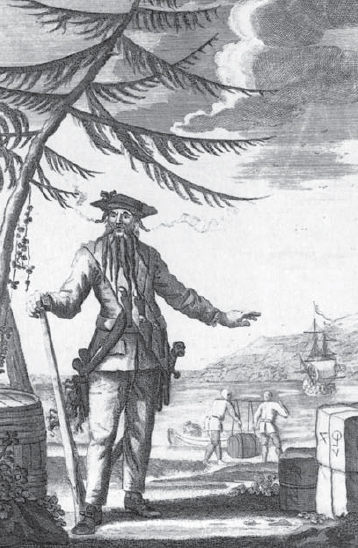

These days, pirates are generally regarded as larger-than-life caricatures – people who exist more in the pages of fiction or the cinema screen than in the historical past. Like gunfighters of the Wild West or Arthurian warriors they are usually seen as semi-fictional creatures, whose real exploits have been submerged in a tidal wave of myth and fictional make-believe. Despite the recent upsurge of piracy in East African waters, piracy has largely become divorced from the harsh realities which once surrounded it, or which still do today.
To the seafarers of the early 18th century piracy was no fantasy. It was a brutal and very real threat to their lives and livelihood. To sail through the pirate-infested waters of the American Atlantic seaboard or the Caribbean was to risk an encounter with pirates who bore no resemblance to our modern caricature of them. These people would kill indiscriminately, torture for amusement, and rob for their own gratification. If the seaman was lucky he would escape with his life. Others were not so fortunate.
Of course, piracy wasn’t a new phenomenon. It had existed since ancient times – even Julius Caesar had an encounter with pirates some 1,800 years before Blackbeard was first heard of. Piracy was a cyclical curse – it thrived in areas where there was little central authority or effective naval presence, and it was generally suppressed through the imposition of law, and by aggressive naval patrolling. The decade from 1714 to 1724 saw one of these dramatic increases.
Pirates established themselves in the Bahamas, and ranged as far afield as Newfoundland and the coast of Brazil, attacking merchant ships, and largely evading capture. It took a concerted effort to quell this tide of crime, but by 1718 it looked as though it was largely under control. Only a few pirate crews remained at large. One of them was led by Edward Teach – better known as Blackbeard. He was only one of many pirates who operated in these waters during this period – an age known as ‘The Golden Age of Piracy’. Others included Bartholomew Roberts (‘Black Bart’), Charles Vane, ‘Calico Jack’ Rackam, ‘Gentleman’ Stede Bonnet, ‘Black Sam’ Bellamy, and the two women pirates Anne Bonny and Mary Read. Despite their exploits, most of these pirates are now half-forgotten. By contrast Blackbeard still remains a household name. Others were more brutal, or captured more ships, or had longer piratical careers. It was Blackbeard, however, who became the most notorious pirate of his day, and who remains so some three centuries after his death.
There are three main reasons for this. First of all, Blackbeard looked the part. He cultivated a sinister appearance to intimidate his victims, and this made him a larger-than-life character even while he was still alive. Secondly, his exploits formed the core of a biography of pirates, published just eight years after his death. He quickly became the archetypal pirate of the ‘Golden Age’. Finally, in 1718 he almost single-handedly brought merchant trade to a halt in colonial North America. His blockade of Charleston caused such widespread alarm that he became the 18th-century equivalent of ‘Public Enemy Number One’.
More than anything this attack against the main port of the South Carolina colony made Blackbeard the most feared pirate in American waters. The fragile economies of the American colonies relied extensively on maritime trade, and Blackbeard posed such a serious threat to this economic lifeline that action had to be taken. This, though, occurred at the time of a royal initiative to pardon pirates who turned themselves in, in the belief that this would reduce the scale of the problem. While the policy worked, it also meant that Blackbeard remained a threat, whether he was actively cruising for prey or not.

According to his first biographer, Captain Johnson, Edward Teach was known as Blackbeard ‘from the hair, which, like a frightful meteor, covered his whole face, and frightened America more than any comet that had appeared there a long time’.
While most colonial governors limited their response to complaining to London and demanding naval protection, Governor Alexander Spotswood of Virginia was a man of action, who decided to take matters into his own hands. Even though Blackbeard was officially a pardoned criminal, and resident in a neighbouring colony, Spotswood decided to attack the pirate in his own lair, and so remove the threat he posed once and for all.
Therefore the scene was set for what would become the most successful anti-piracy raid of the entire ‘Golden Age of Piracy’. What unfolded was a drama worthy of a Hollywood film, only one with a real piratical cast, and which actually happened. Just over 300 years ago, the most notorious pirate in history met his match.